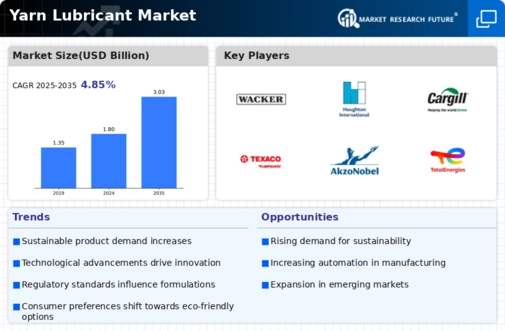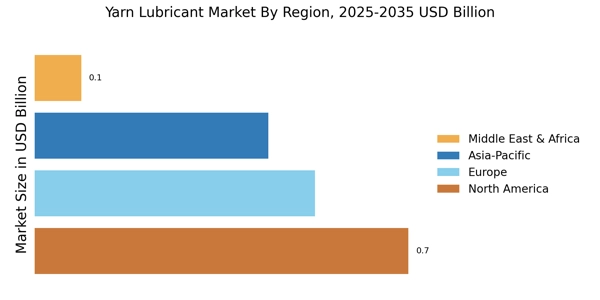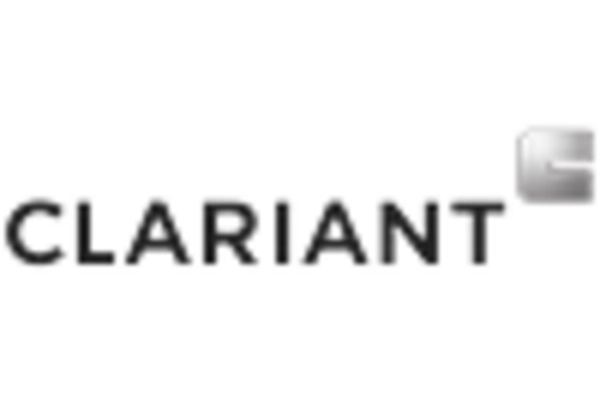Rising Demand for High-Performance Yarns
The Yarn Lubricant Market is experiencing a notable increase in demand for high-performance yarns, driven by the textile sector's need for enhanced durability and functionality. As manufacturers strive to produce yarns that can withstand rigorous conditions, the requirement for specialized lubricants becomes paramount. This trend is reflected in the projected growth of the yarn market, which is expected to reach USD 30 billion by 2026. Consequently, the Yarn Lubricant Market is likely to benefit from this surge, as lubricants play a crucial role in improving the performance characteristics of these advanced yarns. The integration of high-performance lubricants not only enhances the production process but also contributes to the overall quality of the final textile products, thereby fostering a competitive edge in the market.
Increased Production of Technical Textiles
The Yarn Lubricant Market is poised for growth due to the rising production of technical textiles, which require specific yarn properties for various applications. Technical textiles, utilized in industries such as automotive, aerospace, and medical, demand yarns that exhibit superior strength, flexibility, and resistance to environmental factors. This shift towards specialized textiles is anticipated to drive the demand for tailored yarn lubricants that can meet these stringent requirements. The technical textile market is projected to grow at a CAGR of 4.5% through 2027, indicating a robust opportunity for the Yarn Lubricant Market to expand its offerings. As manufacturers adapt to these evolving needs, the development of innovative lubricants will be essential to ensure optimal performance and longevity of technical yarns.
Sustainability Initiatives in Textile Manufacturing
The Yarn Lubricant Market is increasingly influenced by sustainability initiatives within textile manufacturing. As consumers and regulatory bodies emphasize eco-friendly practices, manufacturers are compelled to adopt sustainable production methods. This shift is leading to the development of bio-based and biodegradable yarn lubricants, which align with the growing demand for environmentally responsible products. The market for sustainable textiles is expected to grow significantly, with projections indicating a value of USD 120 billion by 2027. Consequently, the Yarn Lubricant Market must adapt to these trends by investing in research and development of sustainable lubricant solutions that not only meet performance standards but also minimize environmental impact.
Technological Innovations in Lubricant Formulations
The Yarn Lubricant Market is witnessing a wave of technological innovations in lubricant formulations, which are enhancing the efficiency and effectiveness of yarn production processes. Advances in chemical engineering and material science are leading to the creation of lubricants that offer superior performance characteristics, such as improved heat resistance and reduced friction. These innovations are crucial as they enable manufacturers to optimize their production lines, thereby increasing output and reducing costs. The market for advanced lubricant formulations is expected to grow, with a focus on developing products that cater to the specific needs of various yarn types. This trend suggests that the Yarn Lubricant Market will continue to evolve, driven by the need for high-quality, efficient production solutions.
Expansion of the Textile Industry in Emerging Markets
The Yarn Lubricant Market is likely to benefit from the expansion of the textile industry in emerging markets, where economic growth is spurring increased textile production. Countries in Asia and Africa are experiencing a surge in textile manufacturing, driven by lower labor costs and rising domestic demand. This growth presents a significant opportunity for the Yarn Lubricant Market, as manufacturers in these regions seek to enhance their production capabilities. The textile market in these areas is projected to grow at a CAGR of 5% through 2028, indicating a robust demand for yarn lubricants that can support this expansion. As manufacturers invest in modernizing their facilities, the need for high-quality lubricants will become increasingly critical to ensure efficient and sustainable production.


















Leave a Comment